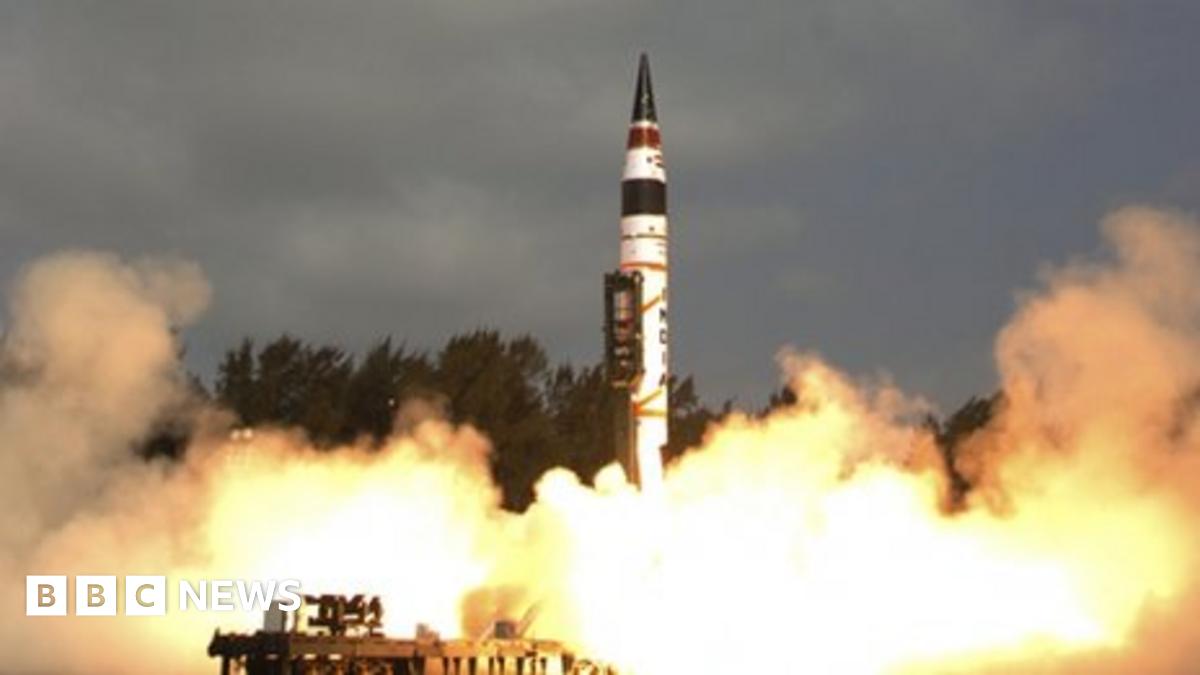Being a solid fuel rocket it's hell and gone more advanced than what NK tried to launch in terms of military utility; no need to fuel it allows them to launch in minutes, easier storage, easier to use on mobile launchers etc. It also gives them a leg-up in developing the upgraded SLBM for their new nuclear submarine fleet.
India test launches Agni-V long-range missile
India has launched a long-range intercontinental ballistic missile able to carry a nuclear warhead, say media.
The locally-developed Agni-V missile was originally scheduled to have been launched on Wednesday in the eastern state of Orissa.
Defence officials had delayed the launch until Thursday because of heavy lightning in the area.
The missile has a range of more than 5,000km (3,100 miles), within range of targets in China.
Analysts say the Agni (meaning "fire" in Hindi and Sanskrit) missile family is to be the cornerstone of India's missile-based nuclear deterrent.
The missiles are among the country's most sophisticated weapons.
In 2010, India successfully test-fired Agni-II, an intermediate-range ballistic missile with a range of more than 2,000km (1,250 miles).
The Agni-V missile was launched from Orissa's Wheeler Island at 0805 on Thursday.
It is, however, not immediately clear if the launch met all the test parameters, says the BBC's Sandeep Sahu in Orissa.
'Deterrent'
The missile will take about 20 minutes to hit its target somewhere near Indonesia in the Indian Ocean.
The status of the test will be known only after the data from the monitoring stations set up along the entire flight path, including two on Indian Navy warships, are analysed, sources told the BBC.
The sources said the flight path of the missile over the full range of 5,000 km will be monitored by Defence Research and Development Organisation (DRDO) scientists from launch to the point of impact in order to study its accuracy.
Defence analyst Rahul Bedi says a successful test flight of the Agni-V missile, which is capable of delivering a single 1.5-ton warhead deep inside nuclear rival China's territory, would strengthen India's nuclear deterrence once it comes into service by 2014-15.
It is 17.5m tall, solid-fuelled, has three stages and a launch weight of 50 tons. It has cost more than 2.5bn rupees ($480m; £307m) to develop.
Only China, Russia, France, the US and UK have such long-range missiles. Israel is thought to possess them.
"Agni-V is to meet our present-day threat perceptions, which are determined by our defence forces and other agencies," DRDO Ravi Gupta spokesman told AFP news agency ahead of the launch.
"This is a deterrent to avoid wars and it is not country-specific," he said.
India has launched a long-range intercontinental ballistic missile able to carry a nuclear warhead, say media.
The locally-developed Agni-V missile was originally scheduled to have been launched on Wednesday in the eastern state of Orissa.
Defence officials had delayed the launch until Thursday because of heavy lightning in the area.
The missile has a range of more than 5,000km (3,100 miles), within range of targets in China.
Analysts say the Agni (meaning "fire" in Hindi and Sanskrit) missile family is to be the cornerstone of India's missile-based nuclear deterrent.
The missiles are among the country's most sophisticated weapons.
In 2010, India successfully test-fired Agni-II, an intermediate-range ballistic missile with a range of more than 2,000km (1,250 miles).
The Agni-V missile was launched from Orissa's Wheeler Island at 0805 on Thursday.
It is, however, not immediately clear if the launch met all the test parameters, says the BBC's Sandeep Sahu in Orissa.
'Deterrent'
The missile will take about 20 minutes to hit its target somewhere near Indonesia in the Indian Ocean.
The status of the test will be known only after the data from the monitoring stations set up along the entire flight path, including two on Indian Navy warships, are analysed, sources told the BBC.
The sources said the flight path of the missile over the full range of 5,000 km will be monitored by Defence Research and Development Organisation (DRDO) scientists from launch to the point of impact in order to study its accuracy.
Defence analyst Rahul Bedi says a successful test flight of the Agni-V missile, which is capable of delivering a single 1.5-ton warhead deep inside nuclear rival China's territory, would strengthen India's nuclear deterrence once it comes into service by 2014-15.
It is 17.5m tall, solid-fuelled, has three stages and a launch weight of 50 tons. It has cost more than 2.5bn rupees ($480m; £307m) to develop.
Only China, Russia, France, the US and UK have such long-range missiles. Israel is thought to possess them.
"Agni-V is to meet our present-day threat perceptions, which are determined by our defence forces and other agencies," DRDO Ravi Gupta spokesman told AFP news agency ahead of the launch.
"This is a deterrent to avoid wars and it is not country-specific," he said.


Comment